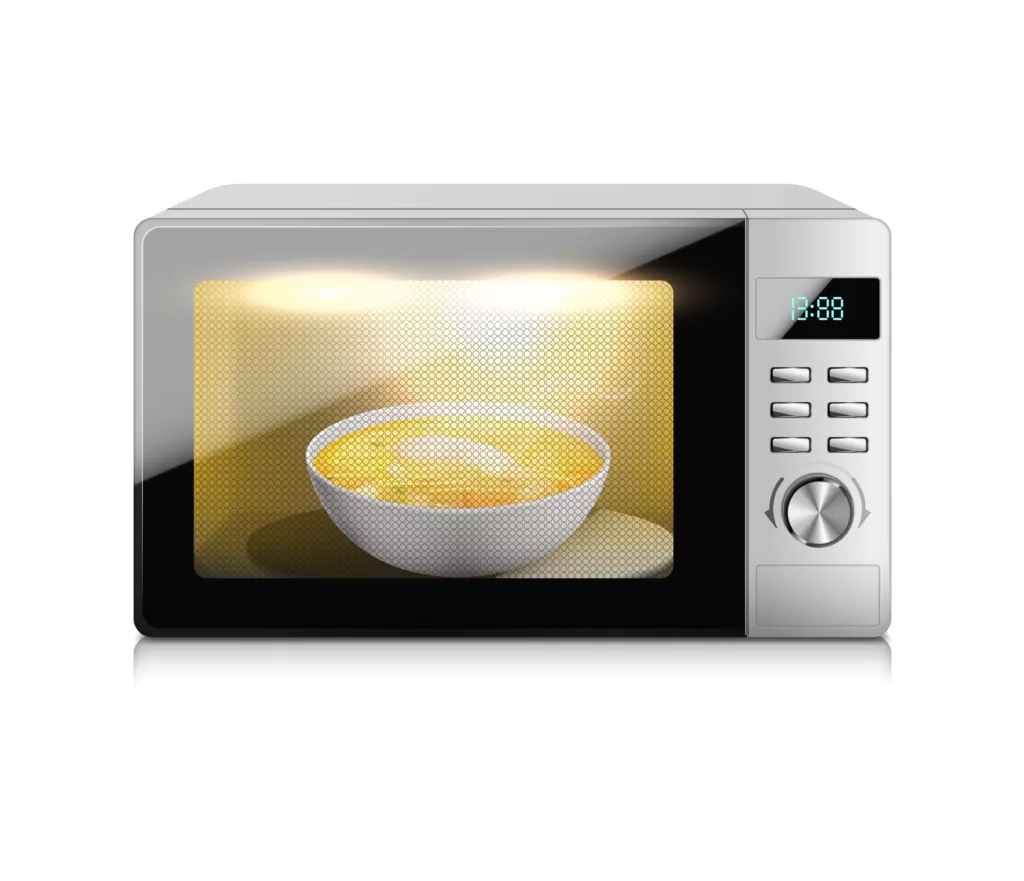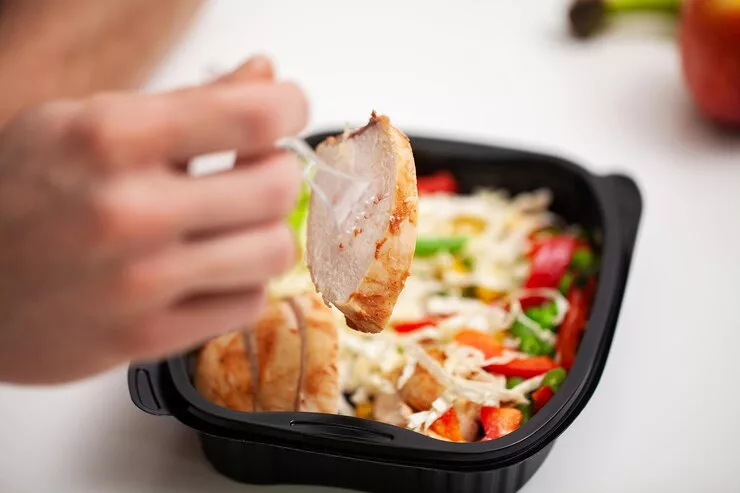Not everyone has the time (or the will) to grill chicken breast and steam zucchini every single day.
And I know that very well.
There was a time — a long one, like years — when my diet was 80% ready meals, 15% protein powder, and 5% fruit forgotten in my backpack.?
And yet… the muscles still grew.
Not Men’s Health cover-model material, okay, but enough to get that classic “you’ve been working out, huh?” from friends I hadn’t seen in months.
So yes, you can build muscle with frozen meals and microwave dishes.
But it takes a bit of strategy. Let’s see how.
The question that matters: are you eating enough protein?

Muscles grow when you give them the stimulus (training) and the building blocks (protein).
It doesn’t matter if those blocks come from a hand-cut beef steak or a frozen pre-cooked burger: what matters are the amino acids.
Many modern ready meals — especially those labeled “Fit,” “Protein,” “Active,” etc. — already contain between 20 and 30 grams of protein.
If you pair them with a whey shake and maybe a snack like cottage cheese, Greek yogurt, or pre-boiled eggs (which are now sold everywhere), you’ll easily hit a solid daily intake.
How much protein per day do you need? Roughly:
- 1.6 – 2.2 grams per kg of body weight
- If you weigh 75 kg: between 120 and 165 grams per day
You don’t need to hit that in one meal, and it doesn’t matter if it comes from a “fitness” plate heated in 3 minutes.
What matters is hitting the total. Day after day.
But doesn’t the microwave destroy everything? False.
It’s one of those urban legends that just won’t die.
The truth is, the microwave is actually one of the gentlest cooking methods.
It cooks quickly without immersing food in water (like boiling), which helps preserve many heat-sensitive vitamins.
For example:
- Vitamin C and B-complex get lost more in long water-based cooking
- The microwave, cooking fast and “dry,” often preserves more
Bottom line: the microwave doesn’t destroy protein, doesn’t erase fiber, and doesn’t turn your food into plastic.
The real issue isn’t frozen food, but which one you choose
Not all ready meals are created equal.
Some are sodium bombs with 4 grams of protein and more sugar than dessert.
Others are balanced, convenient, and perfect as “building blocks” for your daily meals.
Here’s what to look for on the label:
- Protein: at least 20g per meal
- Fat: ideally under 15g (they shouldn’t dominate)
- Sodium: under 700 mg if you eat more than one a day
- Fiber: at least 3g to aid digestion and satiety
- Calories: between 400 and 600 for a light bulk meal
Possible deficiencies (and clever fixes)
Okay, there are weak spots in a microwave-heavy diet.
I’m not saying avoid it, just know where to improve:
- Micronutrients: vitamin D, magnesium, and potassium often lacking in ready meals
- Omega-3s: without fatty fish (like salmon, mackerel), you might fall short
- Gut variety: few fresh foods = bored microbiome
Practical solutions:
- Take a multivitamin (don’t overdo it, but it helps)
- Eat nuts, flax seeds, frozen veggies (yes, they’re good too)
- Occasionally add probiotic yogurt or kefir
- One banana a day: potassium guaranteed
- One kiwi or orange a day: portable fiber and vitamin C
- Add dry spices like turmeric, oregano, chili: flavor + antioxidants
Why Less Stress Equals More Gains
Know what ruins most gym progress?
Diet frustration.
People who want to start super clean, cook everything from scratch, and quit after a week because “I just can’t stay this strict.”
The truth?
Frozen food can become your consistency ally.
It frees up time.
It removes the stress of measuring portions.
It lets you avoid skipping meals.
And over time, that’s worth more than any gourmet recipe.
How to upgrade ready meals without cooking anything
You’ve got your frozen chicken and rice meal?
Great.
Now turn it into a nutritional bomb in two moves.
- Add a teaspoon of extra virgin olive oil after heating to boost healthy calories
- Or toss in a handful of flax or pumpkin seeds: seconds to add, packed with good fats and fiber
If you’re feeling bold, mix some Greek yogurt with mustard or spices to create a quick, protein-packed sauce.
You don’t have to become a chef, but these little upgrades do make a big difference over time.
The best frozen foods to choose if you train

The freezer isn’t just home to cheese pizza and breaded snacks.
If you know what to look for, it becomes a muscle-building arsenal.
Here’s what’s worth throwing in the cart:
- Frozen salmon fillets: high in protein and omega-3s. Even microwave-friendly.
- Microwaveable bagged veggies: no excuses to skip fiber.
- Brown rice or basmati in 2-minute pouches: great post-workout.
- Pre-packed “fitness” trays with chicken and veggies: some actually have solid macros.
Pick 4–5 different meals, rotate them, and keep things from getting boring.
Even your taste buds want a pump now and then.
How long can you live the “microwave life” without issues?
If you’re asking: “Okay, but how long can I live this microwave life before my body sues me?” — relax.
If you’re nailing your macros, training, and basic supplements, you can go for months like this.
When should you consider switching it up?
- If you feel bloated or digestion gets sluggish
- If progress stalls
- If you mentally burn out eating the same 3 meals
Then try a simple move: cook 1 or 2 meals yourself on the weekend.
Just to switch it up, remind yourself you can still use a stove, and stimulate your body in new ways.
How to use ready meals as a “base” for flexible eating
Many think: “If I only eat ready meals, I’m always eating the same thing.”
Wrong.
You can use the ready meal as a base and build around it flexibly, depending on your day and needs.
Practical example:
- Hungry? Add a whole wheat wrap or sandwich on the side
- Cutting? Skip the cheese and add extra veggies
- Post-workout? Add a banana and a protein shake to round it out
The trick is to stop seeing these meals as closed solutions and start treating them as modular bricks.
The role of ready meals in “zero-hassle” meal prep
No time for a Sunday two-hour meal prep with 18 Tupperware lined up?
Welcome to the club.
Here’s where ready meals save your life:
- You can always keep 3–4 emergency meals in the freezer
- You can throw in a few handy snacks too — like we said earlier, nuts, dried fruit, yogurt, bars… the usual suspects.
- You don’t need pots, containers, or a giant fridge
A smart strategy is creating your own “mixed meal prep”:
- 2 home-cooked meals on Sunday (e.g., pan-fried chicken and rice)
- 3 ready meals in the freezer
- 2 pre-packed “lifesaver” snacks
Done — full week covered, zero kitchen slavery.
Can it help you save money? Yes, if you choose wisely
There’s this myth that ready meals are more expensive.
But if you look closely, some cost less than 4–5 euros per portion and save you from wasting food or buying ingredients you’ll use once.
In fact, considering that:
- You waste nothing
- You don’t use gas or electricity to cook
- You avoid €20 takeout orders because “there’s nothing ready”
In many cases, a well-chosen ready meal is cheaper than a badly improvised homemade one.
RELATED:》》》Does drinking olive oil for calories actually help skinny guys bulk faster?
Conclusion
Yes, you can build muscle even with frozen food
If:
- You hit your daily protein target
- You’re in a calorie surplus (to grow)
- You train with effort
- You sleep and recover decently
Then yes: you can grow even with the “3-minute microwave meal.”
It’s not the perfect solution, but it’s a functional one.
And in real life — between work, school, curveballs, and fatigue — that might be exactly what you need.
So if you didn’t cook today, but ate two protein-packed frozen meals, a shake, a banana, and a yogurt…
You’re on the right path.
Don’t let the myth of the “perfect diet” stop you from making real progress.

